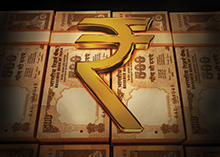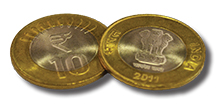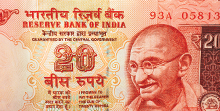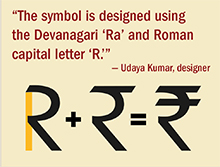Currency Notes
More Than Symbolic Value
Finance & Development, December 2015, Vol. 52, No. 4

When India chose a symbol for its rupee, it joined a select club of countries
Liza Minnelli and Joel Grey may have to add another currency to the famous quartet that makes the world go round. “A mark, a yen, a buck, or a pound . . . Is all that makes the world go around,” they sing in Cabaret in their famous duet at Berlin’s decadent Kit Kat Klub.
Now India has a symbol for its rupee to make the currency as easily recognizable as the yen or the dollar.
Distinctive identity
Besides representing monetary value, for many countries a symbol can be a source of national pride and identity, evoke a country’s hopes and aspirations, and occupy a coveted place on computer keyboards.

This was the thinking behind the Indian government’s search for a rupee symbol to replace the “Rs” abbreviation. In February 2009, a nationwide contest invited entries for a symbol that “reflects and captures the Indian ethos and culture.” With a formal symbol, then Finance Minister Pranab Mukherjee (now president of India) declared, “the rupee will join the select club of currencies such as the U.S. dollar, British pound sterling, euro, and Japanese yen that have a clear distinguishing identity.” In addition, a symbol would help separate India’s currency from others with similar or identical names, like Nepali, Pakistani, and Sri Lankan rupees and the Indonesian rupiah.
“This symbol now lends a distinctive character and identity to the Indian currency.” —Indian President Pranab Mukherjee, 2012 (then finance minister)
The new rupee symbol was unveiled July 15, 2010; officially approved by the government of India on August 26, 2010; and went into circulation about a year later.
Designed by academic and designer Udaya Kumar—the symbol was selected from over 3,000 submissions and a short list of five finalists. Today Kumar’s winning design is found on all Indian currency notes and coins (not to mention stamps, checkbooks, and keyboards), marking India’s as only the second currency in the world—the first being the U.K. pound (£)—whose distinctive symbol is printed on its notes.
Once in a lifetime

Launching a currency symbol is a rare event. The euro’s (€) was one of the most recently introduced, in 1999. Russia’s search in 1999 for a symbol to represent the ruble proved fruitless. Many other countries rely on simple abbreviations of their currency’s name, while others combine a letter abbreviation with the dollar sign.
Some monetary symbols have literal origins. The British pound sign, £, evolved from the Latin word libra, meaning scales, since the pound was originally worth exactly one pound of pure silver.
For India, the process was more complicated. India sought a currency symbol that would capture the culture, ethos, and diversity of India—17 languages are represented on its rupee notes—and have international appeal.
Unique and universal

The winning design achieved just that: it is a combination of the letter “Ra” in Devanagari script—used to write Hindi, India’s official language, and recognizable by the horizontal top line from which its letters hang—and the Latin “R” without the verticle line. “This amalgamation traverses boundaries across cultures giving it a universal identity, at the same time symbolizing our cultural values and ethos at a global platform,” wrote Kumar in his design proposal.
The symbol also distinguishes itself in other ways. The parallel lines at the top (with white space between them) allude to the tricolor Indian flag as well as to the arithmetic equal sign—symbolizing the nation’s desire for balance, stability, and economic equality within and among other nations.
While much remains to be done to boost growth and equality within India, the symbol serves as a powerful reminder of the country’s aspirations to become a global player. ■


